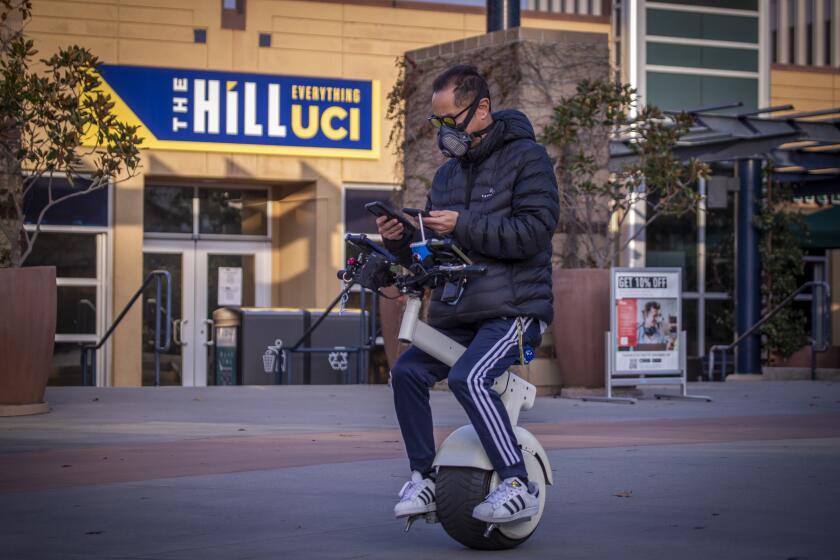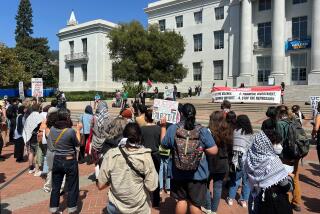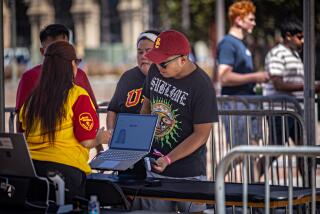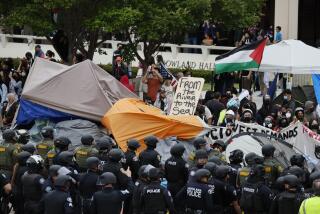UCLA students stage sit-in, demand online options as UC in-person return sparks division
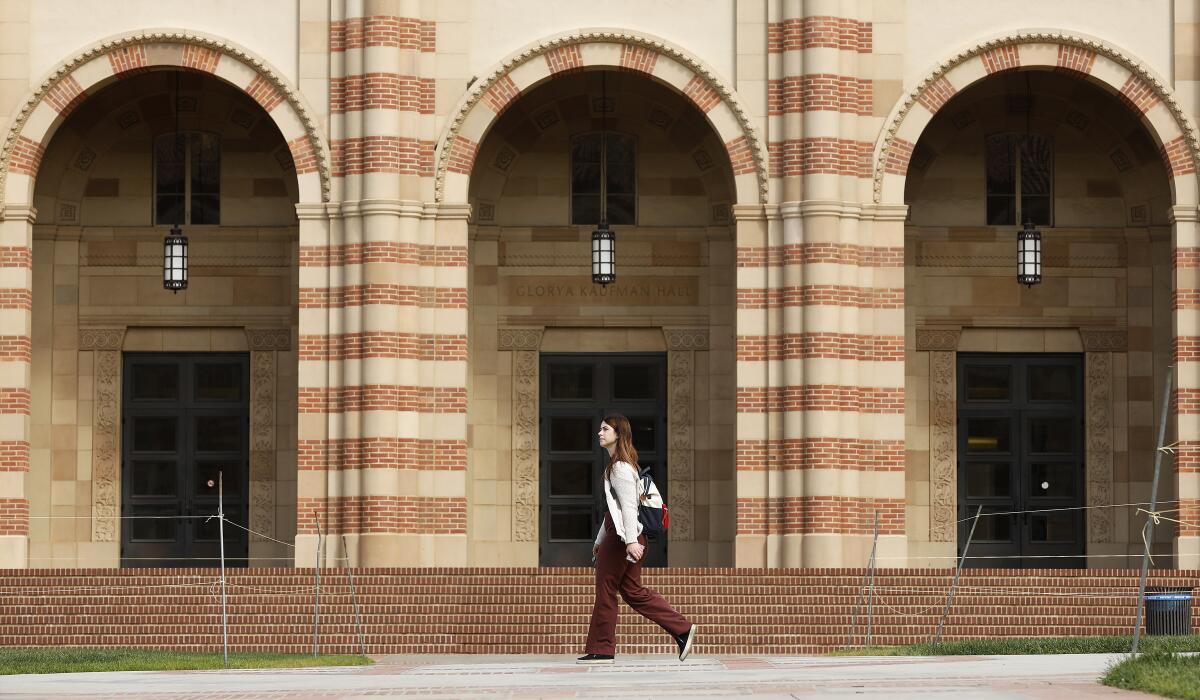
UCLA students staged a sit-in Monday to demand continued online learning options as the University of California’s reopening of classrooms amid the continuing pandemic sparked widespread division over remote vs. in-person instruction.
After a largely in-person fall term, the UC system’s nine undergraduate campuses shifted to remote classes through January as a precaution against the highly contagious Omicron variant. But the return to mostly in-person classes — encouraged by high vaccination rates and signs that the surge has peaked — is anything but smooth.
At UCLA, more than 1,300 people supported a petition urging a boycott of classes Monday and demanding student flexibility to choose between in-person and remote options. Groups representing disability rights advocates, underrepresented students and undergraduate student leadership joined forces to organize a sit-in at the campus administration building and vowed to continue the protest until their demands for online access and educational equity were met.
By early evening, dozens of students sat along a hallway, equipped with blankets, laptops and food; Chancellor Gene Block’s office doors were plastered with fliers accusing UCLA of not caring about Black students or those with disabilities.
“We’ll continue to fight,” said Breeze Velazquez, UCLA undergraduate student body president, who joined the sit-in.
In a statement, UCLA said it recognized the students’ concerns, respected their right to express their views and was “deeply committed” to equity. The campus returned to in-person learning “based on a careful assessment of the current public health situation, including that COVID-19 cases and test positivity rates are rapidly declining on campus and across Los Angeles County, and that many eligible Bruins have received the required boosters,” the statement said.
UCLA’s seven-day average case positivity rates have fallen from 8.2% at the start of winter quarter Jan. 3 to 2.6% as of Jan. 24 and 99% of students, staff and faculty have been vaccinated or received approved exemptions.
Students at UC Davis and UC Irvine also are planning walkouts this week to amplify similar demands for more flexibility. Some faculty are supportive, including UC Irvine’s sociology department. But others say that extending both options for all courses would be a major strain without many more instructors, since delivering quality online education requires far more than simply recording and posting a lecture.
Meanwhile, campus plans for return vary widely. UC San Diego is allowing faculty to choose to stay online through the quarter, while UC Berkeley is generally requiring a full in-person return. UCLA is allowing two additional weeks of remote teaching with a longer duration considered under certain conditions. The decisions are made by each campus’ Academic Senate, in partnership with administration, and it is unclear how many classes ultimately will stay at least partly remote.
“It’s a total mixed bag at every UC campus,” said Robert Horwitz, the UC Academic Senate chair. “The takeaway is there is no way faculty leaders on campus can deliver policy on teaching modality without some key constituency of students or faculty being unhappy. It’s really not easy.”
California colleges, both public and private, announce extension of remote instruction, saying high positivity rates call for extra precautions.
Nor is it clear what the system’s 285,000 students want. A UC Santa Barbara survey of about 5,000 students found a near-even split between those who prefer online vs. in-person classes. At UC Irvine, the vast majority of 2,500 students polled last January wanted a mix of both, with just 20% favoring all in-person and 10% preferring all online.
Esmeralda Quintero-Cubillan, a Santa Barbara senior in sociology and UC Student Assn. president, favors both options. They personally want the in-person camaraderie they missed, especially as they prepare to graduate this year. But the UC student leader also wants the ability to switch to remote. Online options allow students to better protect their health, manage their schedules, save commuting time and increase work hours, they said.
“At the heart of the issue is seeing students have to come back without feeling ready,” Quintero-Cubillan said. “They’re almost being forced to return without having that sense of safety.”
UC officials, however, say their campuses are safer than their surrounding communities. Campuses require vaccinations, boosters, masking, distancing, regular testing and a safety survey to check for symptoms of illness before entering the grounds.
At a UC Irvine student association meeting and another systemwide forum organized by disability rights groups last week, however, several speakers urged dual options — with some decrying a forced in-person return as “horrifying” and “astounding.”
Lacey Wood, a UCI doctoral student in sociology, fears exposure because she has two young children and health issues that leave her vulnerable to infection. Other students live with family members in fragile health or have not been able to return to California due to visa or travel issues. And some who are eager to return say they want to stand in solidarity with those who aren’t.
UC Irvine students are calling for a one-day walkout on Wednesday, along with peers at UC Davis.
Yoseph Ghazal, UC Irvine undergraduate student body president, said he personally can’t wait to return to campus. He missed the small moments: hanging out in the dining hall, checking out student clubs lined up along campus pathways, spontaneous conversations with classmates. But he strongly supports the right of others to make different choices.
“We’re paying thousands of dollars in tuition and housing so we should have the right to say how we want to be educated,” Ghazal said.
Their demands have won support from the UC Irvine Department of Sociology. Faculty have committed “on equity grounds” to continue online learning for the rest of the winter quarter for all students “who self-determine that they need such accommodations, no questions asked,” a department statement said.
UC Irvine Provost Hal S. Stern said the university expects faculty to resume in-person instruction but that department chairs and deans have the authority to decide appropriate policies. He said campus adherence to vaccination, testing, masking and distancing protocols has been extremely high and positivity rates for campus tests have fallen from 17% at the start of winter quarter Jan. 3 to 3% last week. There was no evidence of any classroom transmission last fall, Stern said.
“We believe the campus is safe and we encourage students to attend class,” Stern said.
Faculty across the system remain divided. At UC Berkeley, which is requiring a full return to in-person instruction for everyone without specific exceptions, many faculty are “eager to be free of Zoom” while others are wary, said James Vernon, a history professor and co-chair of the UC Berkeley Faculty Assn.
“I personally believe that campus leadership, who often meet on Zoom or in small settings, should not engage in a giant public health experiment at the potential expense of students and faculty in overcrowded and poorly ventilated classrooms when they are not able or not willing to provide the definitive data (on ventilation standards and classroom transmission) that it is safe,” Vernon wrote in an email.
UC Berkeley leaders say they are hopeful that the worst of the Omicron surge is over but acknowledged the varied sentiments.
“We recognize that some of you are nervous about coming back to campus. Others of you are frustrated that you’re not already in the classroom. This pandemic has presented a series of impossible challenges with often unsatisfying answers,” Chancellor Carol Christ and Provost Catherine Koshland said in a campus message last week.
UCLA endodontics professor Shane White plans to return to full in-person instruction Monday, declining to extend online options for two more weeks as his campus policy allows. Remote learning won’t do for his courses, such as root canal treatment, which students learn on mannequin heads. He returned to in-person teaching in clinics and labs 18 months ago while moving his lectures online.
UC Santa Barbara will allow faculty with children under 5 to continue online instruction, and others who planned in-person courses may switch to remote elements for up to half the course as long as they justify the educational value of doing so.
At UC Riverside, faculty can apply through the department chair and dean to continue remote teaching for the rest of winter quarter.
UC Merced is phasing in its campus return, with all classes completely in person by Feb. 11.
UC Davis expects most classes to be in-person, but faculty with verified COVID-related concerns — such as caring for a child ineligible for vaccination — can continue to teach remotely until the end of the quarter or shift their courses to an online format if they or someone they care for need to isolate.
Velazquez, the UCLA undergraduate student body president, said a faculty member who livestreamed her immigration class fall quarter for those who preferred remote learning did a “phenomenal job” that could be replicated, she said.
But Jessica Cattelino, UCLA Academic Senate vice-chair and anthropology professor, said doing both modes well is far more difficult than it may seem. She said that courses specifically designed for online delivery can be effective, but the emergency shift to remote instruction was a far different matter.
When she made that shift in fall 2020, Cattelino said she significantly redesigned her courses. For instance, she replaced traditional timed midterms and finals for shorter quizzes and recorded lectures in 15-minute chunks, in part to address inequitable access to reliable internet connections.
In an online world, she had to assume students would share information so she recrafted questions that would elicit writings about personal experiences — but that took longer to grade. Cattelino also made her lectures asynchronous, with students viewing them on their own schedules to accommodate different time zones, but that deprived her of direct connections with them. So she added an optional review session for live interaction, adding to her workload.
“I felt it was important to have real time with students,” she said. “But I got no research done.”
Cattelino said it was time for a serious conversation about the additional resources it would take for UC to deliver dual options well. A hasty shift once again to remote learning during a health emergency won’t cut it, she said.
“That is not a sustainable model for the kind of high-quality education UCLA provides,” she said.
More to Read
Sign up for Essential California
The most important California stories and recommendations in your inbox every morning.
You may occasionally receive promotional content from the Los Angeles Times.
